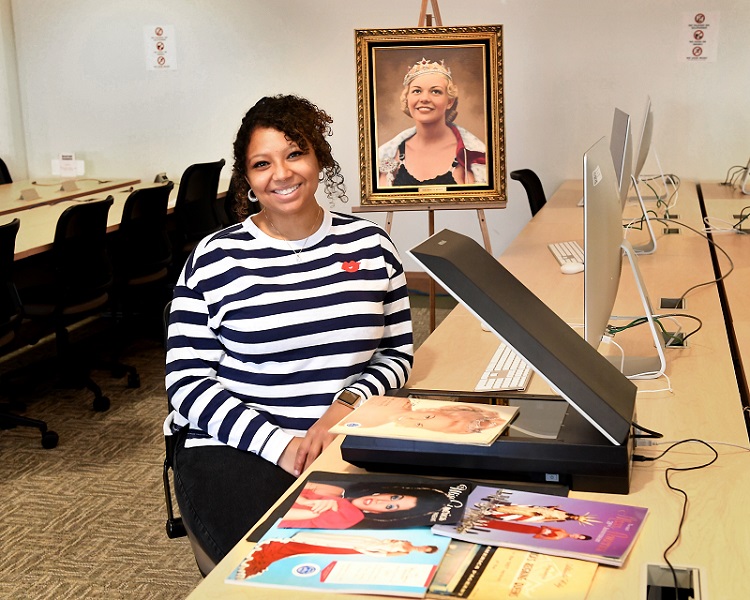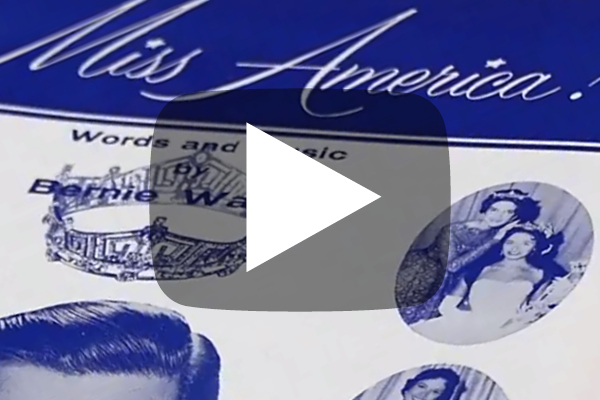With an eye on history and ideals of beauty, students digitize Miss America archives
With an eye on history and ideals of beauty, students digitize Miss America archives

One hundred years of artifacts from the Miss America Organization—from jeweled crowns and velvet capes to programs, photographs, judges’ books, oil paintings, films and business records—tell more than the story of the competition.
They also provide a rich look at both American and New Jersey history and help illustrate how ideals surrounding beauty and women’s roles in society have changed over a century.
Now, through a unique partnership with the Miss America Organization, Rowan University students are sifting through the organization’s expansive archives and digitizing the artifacts. Their work, currently underway in the Digital Scholarship Center at Campbell Library, will be the cornerstone of the new Rowan Digital Collections.
Scholars worldwide eventually will have access to the artifacts through the archive, hosted by Rowan Libraries.
 Currently, the massive Miss America collection is tucked away in storage in South Jersey. The storage contains a treasure trove of floor-to-ceiling artifacts from the competition.
Currently, the massive Miss America collection is tucked away in storage in South Jersey. The storage contains a treasure trove of floor-to-ceiling artifacts from the competition.
The Miss America Organization will continue to retain the physical artifacts. But the digitization, which began with program books and some oil paintings of former winners, will ensure the artifacts are categorized and documented--and available widely to future scholars.
The preservation partnership was orchestrated by University administrators, who were approached by the Miss America Organization.
‘An enduring feature of American culture’
“We’re excited Rowan is doing this and we’re thrilled the University sees value in this project,” says Shantel Krebs, chair of the board and interim president and CEO of the Miss America Organization.
“This is New Jersey history. The digitization project will help others learn more about the quintessential competition and its evolution from a ‘bather’s revue’ into a nationally recognized non-profit that offers scholarship assistance and helps thousands of young women from America to improve their communities through service.”
The project will be a crucial resource to scholars and students, notes College of Humanities & Social Sciences Dean Nawal Ammar.
“The Miss America competition has been an enduring feature of American culture, producing idealized images of female beauty and achievement,” says Ammar.
“However, the pageant also has been a space to challenge those images, both inside and outside the competition hall. This collection will be an invaluable source for the study of American history, culture, women’s history, business history, media studies, and many other topics.”
Project manager Katie Turner, a professor of history and American Studies, says Rowan students working on the digitization are gaining first-hand experience of the archival process.
“This is a great opportunity for our students to get their hands on history and to really see what goes into making a collection,” adds Turner. “Everything today is digitized for students. They often don’t get to see and touch historical documents. When you sift through paper and do research in an archive, there’s a real commitment to the work.”
Founded as a bather’s revue by businessmen in 1921 as a gimmick to lengthen the summer tourist season in Atlantic City by capitalizing on popular American ideals of female beauty, the competition in its early years was often a stepping stone for women who wanted to pursue show business careers. More than 100,000 people swarmed onto the Atlantic City Boardwalk the first year to watch 16-year-old Margaret Gorman be crowned.
Candidates in the 1920s were rated by judges on everything from the construction of their head to their “grace of bearing” to their eyes, hair, torso and hands. Every measurement—from ankles to biceps to head—was recorded by judges and assessed on a points system.
By the 1950s, the competition, under the leadership of Lenora Slaughter, the program’s director for more than 25 years, had been transformed into a source of scholarships for contestants. In 1958, more than $200,000 in scholarships were awarded.
A crown jewel for Atlantic City
But the competition, a crown jewel for Atlantic City, has not been devoid of controversy. In 1968, it was the site of the first major women’s liberation protest in the United States, when the New York Radical Women, some 400 strong, protested on the Atlantic City Boardwalk. They maintained that the competition objectified women and upheld female stereotypes.
Protestors through the years also objected to the program’s exclusion of women of color. The first Black Miss America, Vanessa Williams, was crowned in 1983—more than 60 years after the competition’s founding.
That isn’t lost on Rowan senior English and writing arts major Destiny Hall, who is working on the digitization. She started with the 1984 Miss America magazine, where Williams is featured prominently. Hall, a women’s and gender studies minor, says work on the project has been eye opening as she explores her own views of feminism.
“Part of being a feminist is allowing women to be whatever they want to be. I have a complicated history with Miss America. In the beginning, I saw it as sexist. Now, I see it as a celebration of womanhood. Many of these women compete to further their careers,” says Hall, who will attend graduate school at Columbia University in the fall as she pursues a career writing fiction for women.
“Through this project, I feel like I’m preserving history and I really appreciate that. It’s important to have this information and to have access to it.”
Freshman English major Grace Fox, who is pursuing the Thomas N. Bantivoglio Honors Concentration in the Honors College, is digitizing program books.
“I’m hoping I’ll find one nugget…something nobody knows about,” says Fox. “I’m definitely looking at the advertisements, the kinds of products they marketed, the images of fashion. There’s so much value in this work. It’s so applicable to things we talk about in class, including how societal views on women's bodies are enmeshed in the culture we see.”
Robert Hilliker, interim associate provost and director of research engagement and scholarship at Rowan Libraries, and Michael Benson, digital scholarship specialist, are overseeing the digitization work. Additionally, Center for the Advancement of Women in Communication Director Julie Haynes, whose research focuses on depictions of gender in popular culture, is involved in the project.
About the collection
While programs, photos and other ephemera are being scanned, other artifacts, such as crowns, trophies, and a Waterford scepter carried by winners, will be photographed. Scores of oil paintings and sketches of winners, including some sketches by renowned portrait artist Everett Kintsler, whose work includes official White House portraits of Gerald Ford and Ronald Reagan, will be digitized under the guidance of Rowan art historians.
Rowan’s Department of Radio/Television/Film may assist in digitizing hundreds of films and slides, some of which were donated by shore-area residents who religiously attended the annual Miss America parade on the Boardwalk.
“Prioritization of the digitization will be quite a project,” Hilliker notes. “The collection is so special from an archivist’s standpoint because it contains varied materials. That will make for some interesting research projects, but it also presents a lot of technical challenges. For our students, this project certainly will be an excellent apprenticeship in digital preservation.”
The collection is an eclectic mix.
The same storage that currently houses the unwieldy Golden Mermaid trophy, presented in the early 1920s to the winner, also includes the crown of 1955 winner Lee Meriwether, who went on to a successful television career. Then Miss California, Meriwether was the first Miss America to be crowned on television, an event that drew 27 million viewers.
Stars flocked to the competition over the years. Grace Kelly was a judge. Marilyn Monroe was grand marshal of the parade in 1952. Eddie Fischer was a host before Bert Parks, famed singer of the “There She Is” Miss America theme, emceed for 24 years.
The collection also includes Slaughter’s personal scrapbooks. Some of her other papers are housed at the Smithsonian Institution.
Some of the artifacts, such as the film of Meriwether being crowned, were lost during an Atlantic City Nor’easter some years ago. That makes the digitization project particularly valuable, Krebs notes.
BeBe Shopp, Miss America 1948, says she’s delighted Rowan students are preserving Miss America’s legacy.
“This will make it easier for anyone to view our history and learn how Miss America has grown and become even more vital to young women today,” says Shopp, who represented Minnesota in the competition. “This is important. What an experience the students must be having combing through hundreds of thousands of documents and learning about our past.
“At my age, I’m thrilled that they are going to preserve me for ages to come.”
Supporting the archival work
The Miss America Organization has established a campaign to help fund the digitization project and preserve the thousands of artifacts in the organization’s 100-year history. Visit the organization’s funding site to learn more about supporting the work.